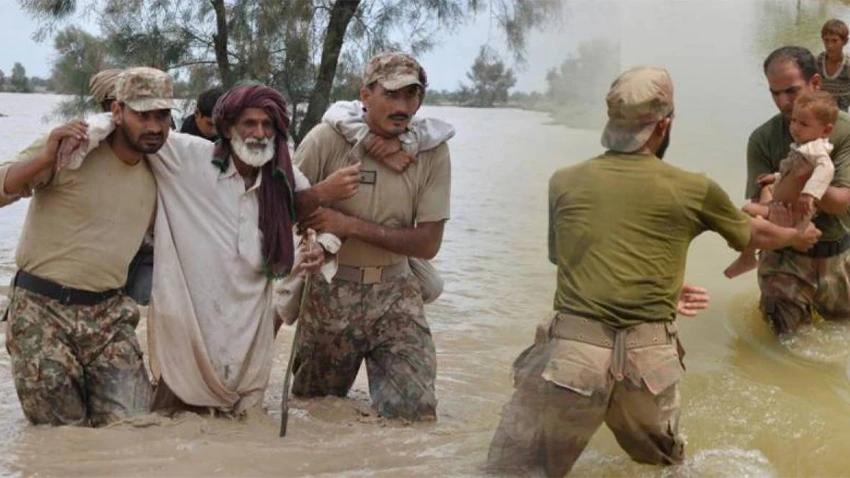Flash floods and landslides have caused large-scale destruction across Khyber Pakhtunkhwa, forcing the Pakistan Army and rescue teams into nonstop operations. Engineers are working day and night to reopen blocked roads and restore access for stranded families in flood-hit districts.
The Army Engineers Corps has already cleared the Pir Baba bypass for all types of traffic. Debris in Pir Baba bazaar was also removed overnight to help residents in Buner. The route leading to Gokand village was reopened at three landslide points, while the Aluch–Poran road was restored with heavy machinery.
Urban Search and Rescue units, using modern equipment, continue operations in Bishoni and Qadir Nagar. Five bodies have so far been recovered from a stream near Bishoni. Officials have promised that rescue work will not stop until every affected area is reopened.
According to the Provincial Disaster Management Authority, at least 341 lives have been lost in Khyber Pakhtunkhwa since Friday due to flash floods caused by heavy rain and sudden cloudbursts. Buner remains the hardest-hit district, with more than 200 deaths. Narrow streets and damaged routes slowed the movement of heavy machinery, further delaying rescue efforts.
Nationwide, the National Disaster Management Authority reported 660 deaths since late June from rain-related disasters. Khyber Pakhtunkhwa recorded 392 fatalities, Punjab 164, Gilgit-Baltistan 32, Sindh 29, Balochistan 20, Azad Jammu and Kashmir 15, and Islamabad 8. Officials confirmed that Buner alone received over 150mm of rain in just one hour on Friday morning.
The devastation has spread to Peshawar, Mardan, Swabi, and Abbottabad. In Swabi, 11 people lost their lives in fresh flash floods on Monday. Houses, shops, vehicles, and other belongings in hilly towns were swept away within minutes.
NDMA Chairman Lt Gen Inam Haider Malik has warned of two more spells of rain between August 21 and September 10. He said new cloudbursts could intensify the disaster and urged readiness.
Meanwhile, the Pakistan Meteorological Department has forecast more widespread rain, wind, and thundershowers across KP, Punjab, Sindh, Balochistan, Kashmir, Gilgit-Baltistan, and Islamabad on Tuesday. Very heavy rainfall is expected in several areas, raising the risk of fresh flash floods in streams and nullahs, particularly in KP, Kashmir, Gilgit-Baltistan, Potohar, Dera Ghazi Khan, Koh-e-Suleman, and northeastern Balochistan.
The Met Office also warned that urban flooding may hit low-lying areas in northeastern Punjab, Islamabad, Rawalpindi, Peshawar, Nowshera, and southeastern Sindh. Landslides remain a major threat in Murree, Galliyat, Kashmir, Gilgit-Baltistan, and vulnerable districts of KP. Strong winds and lightning could further damage fragile structures, including mud houses, electric poles, solar panels, and billboards.
Heavy rain has already battered parts of the country during the past 24 hours. Rawalakot recorded 110mm, Murree 88mm, Chakwal 84mm, Takht Bhai 80mm, and Peshawar Airport 54mm. On the other hand, Dalbandin and Turbat remained the hottest at 43°C, followed by Nokundi at 42°C.
The worsening weather has forced the closure of all colleges and universities in the Counter Zone of KP from August 19 to 25. The Higher Education Department directed institutions to continue classes online to protect students, teachers, and staff from flash floods and landslides. Minister Meena Khan Afridi said special relief steps for students were also under review.
According to official assessments, several education buildings have suffered serious damage. The 300-foot wall of Government Degree College Lalqila in Lower Dir has collapsed. The water supply scheme and tube well at Government Degree College Wari in Upper Dir were destroyed. In Shangla, a 3,000-foot boundary wall of Chakisar College has been washed away. The Girls Postgraduate College in Saidu Sharif, Swat, also lost part of its boundary wall, while Government Degree College Shamozai in Swat was partially damaged. At the University of Shangla, a 1,400-foot pipeline was destroyed, while the Charbagh campus of the University of Swat lost a 40-foot boundary wall. The residential colony of the same university was also hit.
Both provincial and federal governments have pledged support. KP Chief Minister Ali Amin Gandapur announced donations from salaries: one month from the CM, 15 days from cabinet members, seven days from lawmakers, two days from officers, and one day from lower staff. Prime Minister Shehbaz Sharif declared that the federal cabinet would also donate one month’s salary to aid victims.
Federal Minister for Climate Change Musadik Malik assured that roads would be reopened within 24 hours. He said the Centre was working with provinces “without discrimination” to restore normalcy.
Landslides and flash floods are now a regular feature of Pakistan’s monsoon. While the rains are vital for agriculture, they also bring destruction each year. Chief meteorologist Zaheer Babar said extreme weather events are rising in frequency and intensity. He warned that poor planning worsens the damage, as houses built along riverbanks, clogged waterways, and garbage dumping block natural flows of rainwater.
Pakistan remains among the world’s most climate-vulnerable nations. The flash floods of 2022 drowned one-third of the country and killed around 1,700 people. This year’s devastation is another reminder of how climate change and human negligence combine to magnify the risks.

